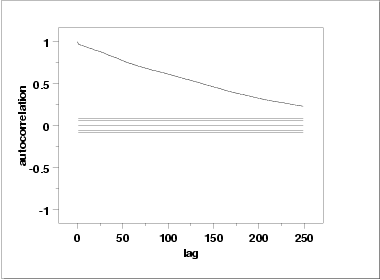1.4. EDA Case Studies
1.4.2. Case Studies
1.4.2.7. Standard Resistor
1.4.2.7.3. |
Quantitative Output and Interpretation |
Sample size = 1000
Mean = 28.01634
Median = 28.02910
Minimum = 27.82800
Maximum = 28.11850
Range = 0.29050
Stan. Dev. = 0.06349
Coefficient Estimate Stan. Error t-Value
B0 27.9114 0.1209E-02 0.2309E+05
B1 0.20967E-03 0.2092E-05 100.2
Residual Standard Deviation = 0.1909796E-01
Residual Degrees of Freedom = 998
The slope parameter, B1, has a
t value of 100.2 which
is statistically significant. The value of the slope parameter estimate
is 0.00021. Although this number is nearly zero, we need to take
into account that the original scale of the data is from about
27.8 to 28.2. In this case, we conclude that there is a drift
in location.
H0: σ12 = σ22 = σ32 = σ42
Ha: At least one σi2 is not equal to the others.
Test statistic: W = 140.85
Degrees of freedom: k - 1 = 3
Significance level: α = 0.05
Critical value: Fα,k-1,N-k = 2.614
Critical region: Reject H0 if W > 2.614
In this case, since the Levene test statistic value of 140.85 is
greater than the 5 % significance level critical value of 2.614, we
conclude that there is significant evidence of nonconstant variation.
One check is an autocorrelation plot that shows the autocorrelations for various lags. Confidence bands can be plotted at the 95 % and 99 % confidence levels. Points outside this band indicate statistically significant values (lag 0 is always 1).

The lag 1 autocorrelation, which is generally the one of greatest interest, is 0.97. The critical values at the 5 % significance level are -0.062 and 0.062. This indicates that the lag 1 autocorrelation is statistically significant, so there is strong evidence of non-randomness.
A common test for randomness is the runs test.
H0: the sequence was produced in a random manner
Ha: the sequence was not produced in a random manner
Test statistic: Z = -30.5629
Significance level: α = 0.05
Critical value: Z1-α/2 = 1.96
Critical region: Reject H0 if |Z| > 1.96
Because the test statistic is outside of the critical region, we
reject the null hypothesis and conclude that the data are not random.
Analysis for resistor case study
1: Sample Size = 1000
2: Location
Mean = 28.01635
Standard Deviation of Mean = 0.002008
95% Confidence Interval for Mean = (28.0124,28.02029)
Drift with respect to location? = NO
3: Variation
Standard Deviation = 0.063495
95% Confidence Interval for SD = (0.060829,0.066407)
Change in variation?
(based on Levene's test on quarters
of the data) = YES
4: Randomness
Autocorrelation = 0.972158
Data Are Random?
(as measured by autocorrelation) = NO
5: Distribution
Distributional test omitted due to
non-randomness of the data
6: Statistical Control
(i.e., no drift in location or scale,
data are random, distribution is
fixed)
Data Set is in Statistical Control? = NO
7: Outliers?
(Grubbs' test omitted due to
non-randomness of the data)

